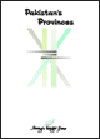Pakistan's Provinces, 2004
 |
ISBN No. 818826205-6
Summary
Pakistan’s biggest challenge will be in the context of relations between the federal government and the provinces. The last two years were marked by agitation in Sindh over the distribution of fiscal resources and water allocation. There have also been attacks on gas pipelines in Balochistan in a similar vein. The spring of 2004 saw the return of an exiled Balochi, Ataullah Mengal, who has revived the Pakistan Oppressed Nations Movement, challenging the centralized structure.
NWFP has evolved a new political system under the leadership of religious parties that is more akin to neighbouring Afghanistan of the 1990s than the progressive and moderate state that General Musharraf has envisioned. Even in Punjab, the largest province, there are signs of strife with the rise of a sub-national movement in the Seraiki region. It would be difficult for Pakistan to cope with these tendencies indefinitely, warranting the need for constructing democratic bridges between the federal government and provinces.
These processes will have implications for Pakistan's provinces. The democratization of institutions will enhance the role of political parties that are currently province-specific. For instance, the Muslim League is mainly a Punjab party, while People's Party is primarily influential in Sindh. The Muttahida Majlis-e-Amal (MMA) has following in NWFP and Balochistan.
The demand for re-organizing relations between the federal and provincial governments will have direct bearing on the future of provinces.
The recent increase in sub-nationalist tendencies can be partially attributed to the democratic deficit in the country. General Musharraf has weakened the two largest and powerful political parties, exiling their leaders. Religious parties and separatist groups are filling the vacuum thus created. If mainstream parties could function without encumbrance, religious and separatist parties would be obviated.
Pakistan's military ruler has a deal-making approach to politics. He seems to believe in resolving disputes between provinces through negotiations. Making structural changes in the political machinery seems nowhere on the agenda.
His strategy has facilitated the perpetuation of his own power, but has emaciated Pakistan's already weak democratic culture. The net outcome — rise in extremism, sectarianism and separatism
In 1971, it was rejection of democracy that led to the division of Pakistan. If the army had honoured the electoral mandate, Sheikh Mujibur Rehman would have been Prime Minister and the country would have still been united. More than thirty years later, the army seems keen to undermine democracy and endanger the integrity of the nation. No wonder, references to 1971 are being made in the political rallies of 2004.
The future of Pakistan's provinces will have bearing on geo-politics of the entire region. Any tension between NWFP and the rest of Pakistan will impact Afghanistan. Problems in Balochistan will affect Afghanistan and Iran. Friction between Punjab and Sindh can cause, in the extreme case, massive refugee influx into India. Thus, the future of Pakistan's provinces will subtly govern the future of extended South Asia.
Attention to Pakistan's provinces is necessitated not only by tensions between Sindh and Punjab, but also by the fluidity in the region bordering Afghanistan and Pakistan. This fluidity always existed, it is the present uncertainty in Afghanistan that is making it significant.
Attention to Pakistan's provinces is also warranted by the increasing references being made to 1971-developments, in the country's political discourses. In 1971, Pakistan became the first major post-colonial state to bifurcate out of inter-provincial differences. In mid-1970s, it was again on the throes of fragmentation due to an agitation in Balochistan. Army intervention quelled the unrest and helped maintain the territorial integrity of residual Pakistan.
Every army chief has gifted Pakistan with loss of territory. General Yahya Khan lost East Pakistan, General Zia-ul-Haq lost Siachen, General Musharraf lost Afghanistan. The next chief runs the risk of losing a lot more, despite friends in a powerful land.
An analysis of Pakistan's provinces, at this juncture, is thus pertinent.
The study begins with a macro overview of Pakistan's economy followed by inter-provincial comparisons that are based on our understanding of Pakistan's economy and society. The subsequent chapters deal with each province separately. Finally, our perspectives are synthesized in an effort to outline future scenarios for Pakistan.
related media coverage
-
Who authored 'Pakistan's Provinces'?
October 21, 2004
-
Provinces' future may affect geo-politics of S Asia: Report
July 26, 2004
-
Jehadi recruitment spawns in Sindh
July 11, 2004
-
Pak. Punjab biggest centre for 'jehadi' recruitment
July 11, 2004
-
Pakistan Provinces
July 11, 2004
-
Pakistan's Punjab biggest centre for 'jehadi' recruitment
July 11, 2004
-
Unemployment mounting in Sindh
March 28, 2004
-
Pakistan and its economy
January 3, 2004


